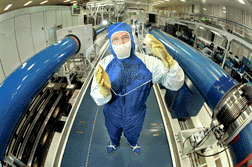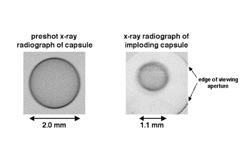FOR IMMEDIATE RELEASE
August 30, 2001
Huge laser confirms step toward nuclear fusion
Z-Beamlet image shows Z evenly compresses pellet
|

SURROUNDED BY Z-BEAMLET — Sandia technologist Benjamin Thurston examines the debris shield that protects the giant Z-Beamlet laser’s final focusing lens from flying debris when the Z accelerator fires. The lens is square because the beam generates an approximately 12-inch-square footprint, like a kind of flying pancake, until focused down to approximately 100 microns.
Download 300dpi JPEG image, ‘Zbeamlet.jpg’, 1.7MB (Media are welcome to download/publish this image with related news stories.)
|
ALBUQUERQUE, N.M. — To create high-yield nuclear fusion that will ultimately produce cheap electric power from sea water, researchers must be able to evenly compress a BB-sized pellet so that its atoms are forced to fuse.
In its first try as a Sandia National Laboratories diagnostic tool, the third-biggest laser on earth, Z-Beamlet, confirmed that Sandia’s Z machine — the most powerful laboratory producer of X-rays in the world — spherically compressed a simulated fusion pellet during a firing, or “shot,” of the giant accelerator.
“The beam compressed the pellet by a factor of 2,” says project leader John Porter, “and demonstrated an encouraging uniformity. Our results show we’re moving in the right direction.”
Uniform 3-D compression is an essential step in creating controlled nuclear fusion. It means that almost none of the X-ray energy delivered to the pellet squirted uselessly away. Weapons simulation work (the alternative to nuclear testing) conducted on supercomputers by Sandia for the US Department of Energy is expected to benefit from data from high-yield explosions, as should, further down the pike, energy production.
Until now, Z researchers had to be content with electronic images of smoother and smoother Z pinches — the tool of compression. The pinch — a vertical magnetic cylinder — with increasing smoothness impels ions of tungsten toward its vertical axis at a considerable fraction of the speed of light. But knowing that the tool is good and getting better isn’t definite information about the pellet upon which the tool is operating. Only direct data is entirely convincing, or, to put it in a more homely way, seeing is believing.

BEFORE AND AFTER — or at least, during — a dummy pellet compressed by Z and monitored by Z-Beamlet “demonstrates an encouraging uniformity,” says project leader John Porter. (Photo by Randy Montoya)
Download 300dpi JPEG image, ‘Zcapsule.jpg’, 192K (Media are welcome to download/publish this image with related news stories.)
|
|
Z-Beamlet images the pellet in a kind of giant dental X-ray, says Porter. In a burst of energy only a fraction of a billionth of a second long, it takes a snapshot by creating a shadow on a piece of X-ray film placed behind the BB-sized pellet inside the central chamber of the firing Z machine. The shadow, like the picture taken of a tooth, accurately depicts what is going on in the “mouth” of Z.
The comparison with the dental X-ray process is closer than it might appear. The laser’s light itself is not used to create the pellet image. Higher frequencies of light are needed to produce better information. So the beam, after traveling horizontally 75 yards from a former warehouse adjacent to the Z building, is turned downward 90 degrees into the maw of Z, where it is focused to a small spot about the diameter of a human hair. Because the duration of the pulse is about 300 picoseconds — about enough time for light, which can travel around the earth seven times in a second, to travel about four inches — an extremely powerful beam is created because of the short time duration in which its energy is expended. The powerful beam striking the metal plate causes the plate to release X-rays. It is these X-rays, as they emanate from a single point, that have the accuracy and intensity to image the pellet.
While pulsed lasers are not new, they normally produce mere millijoules of energy in university research labs. “The Department of Energy (DOE) wants lots of energy,” says Porter, and Z-Beamlet delivers kilojoules of laser energy for its diagnostic work. (Z itself, firing, delivers megajoules.)
Light starts its voyage humbly enough in Z-Beamlet with picojoules (10 to the minus 12 joules) of energy in its initial beam. On a simple metal table — using an assortment of small mirrors, lenses, beam splitters, and polarizers — researchers develop as perfect a “seed” beam as possible. Then, like a pimply teenager drafted for a Hollywood makeover, the little beam is amplified and smoothed to clear up any spatial nonuniformity. Then it is passed through a vacuum chamber in which it is focused into a point source from which it opens again. The entire laser system is run and monitored by an elaborate computer control system residing on five desktop computers. (This is one enhancement of many incorporated into Z-Beamlet to modernize the mid-1990s vintage laser.)
After a final smoothing from an adaptive optics system (a flexible mirror that is continuously pushed and pulled by an array of 39 electromechanical actuators), yet more energy is added to the laser pulse by flash lamps that look like fluorescent tubes.
Lawrence Livermore National Laboratory originally built the Beamlet laser to serve as the scientific prototype of the National Ignition Facility. The California lab decided to remove the laser to make room for those of the NIF.
The entire project to reassemble the recycled Livermore laser cost $12.875 million, took three years to complete, and required the talent and dedication of scores of individuals from Lawrence Livermore and Sandia, says John.
“Now we’re more optimistic than ever,” says John. “Instead of seeing the outside of Z science — the instabilities in the compressing magnetic field — we can now see the inside, the pellet at the center of the million-degree furnace — the interior of the sun, if you will — and we can accurately describe what’s happening there.”
Sandia is a multiprogram laboratory operated by Sandia Corporation, a Lockheed Martin Company, for the United States Department of Energy under contract DE-AC04-94AL85000. With main facilities in Albuquerque, N.M., and Livermore, Calif., Sandia has major research and development responsibilities in national security, energy and environmental technologies, and economic competitiveness.
Media contact:
Neal Singer, nsinger@sandia.gov, (505) 845-7078
Sandia Technical contact:
John Porter, jlporte@sandia.gov, (505) 845-7526
|
